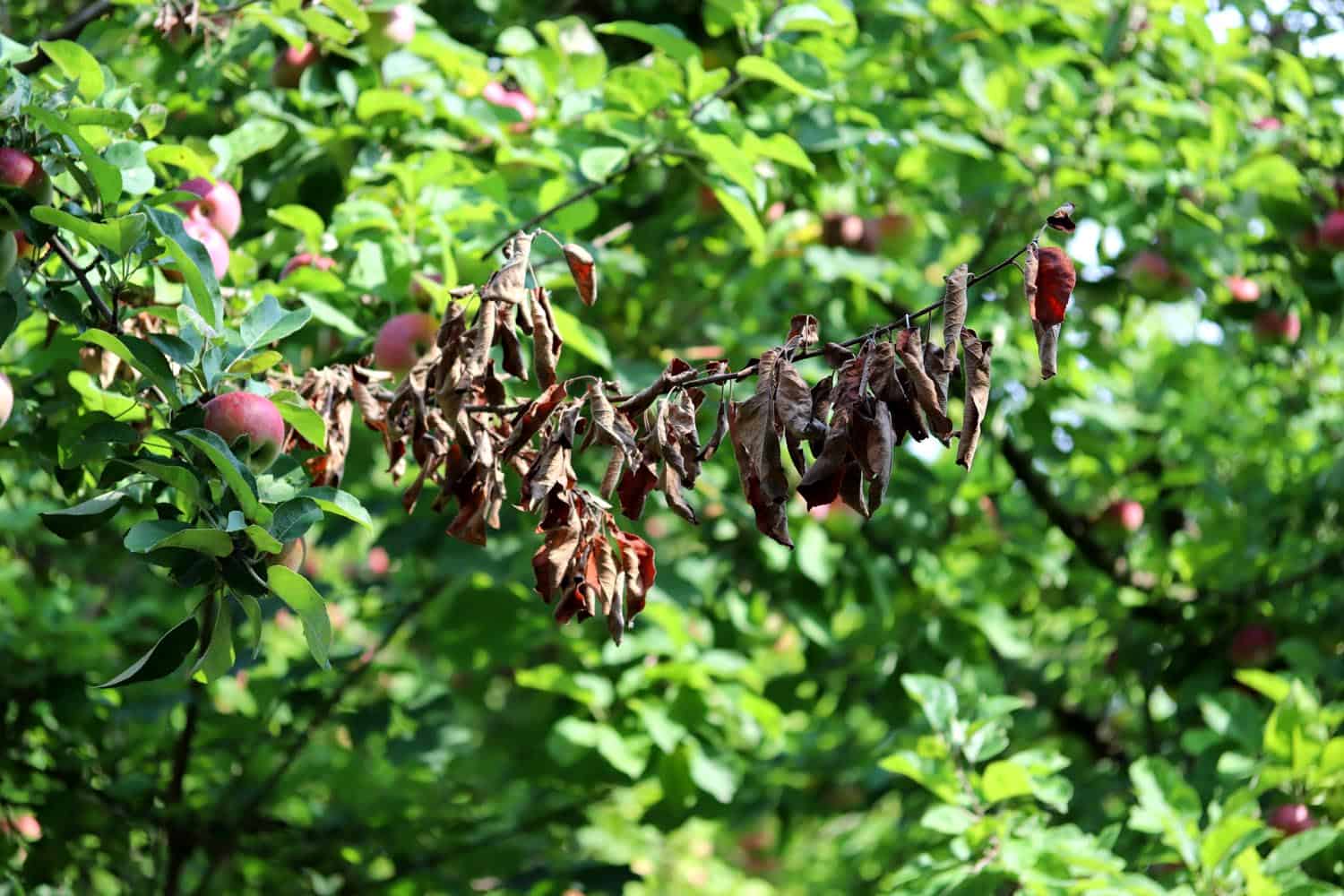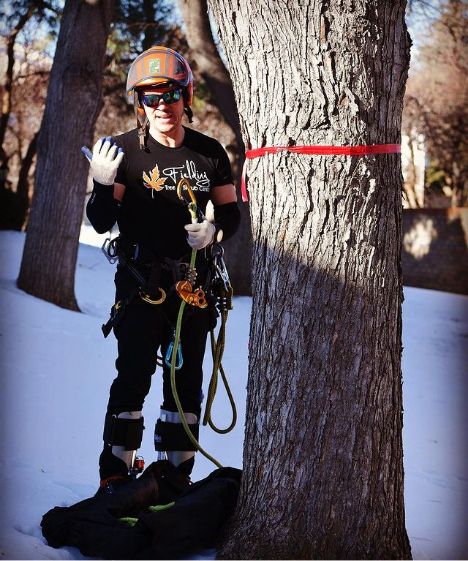The truth is that Denver and the surrounding areas have struggled with fire blight of apple, pear, and other trees in the rose family for many years. It’s been difficult to stop because the disease spreads so easily from one property to the next. And even though the damage looks like burns and the name has fire in it, this disease is 100% bacterial. Many homeowners rely on Denver arborist services to help identify fire blight early and protect their fruit trees.
Do you and your neighbors own fruit trees such as apple or pear? One thing you can do to prevent fire blight in trees in the rose family is talk to your neighbors and keep them informed. Working together to take preventative measures and identifying fire blight of apple trees early are the only ways to beat it!
Fire Blight of Apple and Other Trees
Fire blight is a destructive bacterial disease. Erwinia Amylovora bacteria attacks leaves turning them black, causes branches to develop dark cankers, and makes twigs ooze white puss. Accordingly, this gives the affected tree the appearance of being burned, hence the name. Left untreated, fire blight will kill branches and then the entire tree.
Certainly, you must be wondering if fire blight is harmful for humans, but it is not. If you recently ate a sour apple or pear and are worried about infection, you can relax. Like other plant diseases, fire blight only harms plants. There are a few other questions that our certified arborists are often asked when it comes to fire blight; below are these questions with our answers.
Could Fire Blight Affect My Trees?
Trees that are members of the rose family are most likely to fall victim to fire blight. We like to use the acronym, CHAMP:
- crabapple
- hawthorn
- apple
- mountain ash
- pear
Do you have any of these fruiting and flowering tree species on your property? If so, it is vitally important that you act quickly. The Denver Post reported entire neighborhoods of crab apple trees being wiped out by fire blight!
Don’t assume your trees are healthy. The devastating disease is common and has been prevalent in Denver for a long time. Try to raise awareness with your neighbors who share tree species that are susceptible. It’s incredibly easy for fire blight to spread from one property to the next.
Not sure what tree species you have on your land? Contact our friendly and knowledgeable team of certified arborists for a consultation.
How Does Fire Blight Spread?
Rain, wind, pollinators, and pruning tools will spread fire blight from diseased to healthy trees. Unfortunately, bacteria survive the winter in cankers on already-infected branches. When temperatures warm up in the spring, the bacteria ooze out of the cankers.
The sticky substance attracts aphids, ants, bees, beetles, and flies. Insects pick up the bacteria and carry it on their bodies to the blossoms of healthy plants, spreading the disease. Furthermore, it enters the flower tissue and eventually moves into the branch. Affected branches become girdled and the tissue inside dies.
According to the fact sheet released by Colorado State University Extension, bacterial ooze splashed by rain can also spread the fire blight bacteria. It will seep into natural openings in branches, leaves, pruning and hail wounds.
When Is the Greatest Risk of Fire Blight?
The disease is most serious when spring temperatures during pre-bloom and bloom are warmer than average. The fire blight pathogen spreads particularly rapidly during warm rainy spring seasons. The splashing rain can carry bacteria from an infected tree to a healthy one.
Blight of twig terminals can occur in late May through June during wind-driven rain events. Although spring is the most dangerous time for the spread of fire blight, hail and wind damage provide wounds that allow the pathogen to enter at other times. To effectively protect your trees, you need to treat them before the onset of spring.
Fire Blight Symptoms
There are certain types of bacteria and diseases that can sneak in undetected, conversely fire blight of apple is not one of those. Visual effects of the disease are devastating, and you will notice outward signs of infection right away.
Be on the lookout for these signs and symptoms:
Discoloration
Brown or blackened leaves are the hallmark symptom of fire blight. Evidently, when bacteria have spread through the branch and reached the leaves, they turn crisp and dry. They curl and turn a brownish-black color, looking burnt, though they still stay attached to the tree.
Next, blackened bark is also a sign of the disease. Undoubtedly, fire blight affects all parts of the tree, from the ground up. The bark on the trunk of the tree cankers with infection and turns black. Inner bark that is infected may turn green or brown.
Black “shepherd’s crook” twigs are a sign that the disease has spread significantly. First, the bark at the base of blighted twigs becomes water-soaked, then dark, sunken, and dry. Infected twigs often become bent, resembling a shepherd’s crook.
Discharge
Creamy ooze is an outward sign of the infection taking hold inside the tree. Sticky, creamy colored bacterial ooze may be prevalent on many parts of an infected tree. Said ooze may appear from cankers on the tree bark or diseased twigs, even on infected fruits.
Fire-blight can also cause blossoms to drip with water discharge. During blossom blight, infected blossoms look as though they are seeping with water and wilt right away. They do not fall, but cling to the tree, turning dark brown.
Dead Appendages
These fire blight cankers become so numerous that they kill tree branches. Showing up as sunken, dark discolored areas, with a narrow callus ridge along the outer edge. Subsequently, these ridges differentiate fire blight cankers from other fungal tree cankers.
Dried dead fruits are also a sign of infection. Infected fruits get lesions first, dry out, and continue to hang from the tree without falling.
Fire Blight Treatment
Once a tree is infected there is no way to completely cure it, although there are various treatments available.
1. Trim Trees
Trimming in winter is an effective way to remove heavily infected areas. Trees sustain less damage and have more time to heal when they are trimmed during winter. They will incur less stress and are not at risk of becoming further infected at this time. Once trimmed, infected trees should receive one or more chemical treatments. The bacterial infection is also dormant, allowing arborists to prune without use of disinfectants.
2. Antibacterial Trunk Injection
When your body has an infection, you take an antibiotic. One of the trunk injection treatments we utilize is an antibiotic for your trees! It can be applied yearly in April-May. We recommend treatment in 2 consecutive years with this particular product, to purge the bacteria from the trees system. This method primarily reduces the twig stage of infection, and works best when infections cover less than 40% of the crown. The downside to this treatment is that any edible fruits on treated trees cannot be eaten for 1 year after the last treatment.
3. Boosting Natural Immunity
One alternative method of trunk injection is the application of phosphorous acid to boost the trees natural immunity to fire blight. Applications of this chemical increase the trees production of phenolic compounds, which in turn aid in fighting off the fire blight bacteria. We recommend this treatment as a preventative, or for mild cases of infection. This is most often paired with a canopy spray of phosphorous acid, with sprays and injections occurring once every 2 years, opposite one another. The upside for this treatment is that edible fruits are not affected, and can be consumed in the same year as treatment.
3. Soil Injection
We employ a chemical growth regulator injected into the soil one time during the trees’ growing season. This treatment lasts for at least 3 years, and is best used to prevent severe disease, or rehabilitate moderately infected trees. For trees infected with fire blight, it is used to minimize shoot growth, which will minimize the shoot blight stage of a fire blight infection. This treatment has the additional benefits of improving a tree’s drought tolerance, thickening plant cell walls for improved defenses, and increasing chlorophyll density for improved energy acquisition. As with the antibacterial treatment, edible fruits should not be consumed for a minimum of 1 year post-treatment.
Fire Blight Prevention
Since there is no cure for fire blight, it’s crucial to be proactive and use preventative methods to protect your landscaping. The best way to prevent fire blight is through proper care of trees throughout winter and early spring. This includes:
- winter tree trimming
- winter watering
- spring and fall fertilization
Additionally, you can implement the following best practices:
1. Prune with Care
Remove all blighted twigs and cankered branches. Prune twigs and branches 8 to 12 inches below the edge of visible infection. Spreading the blight bacteria risk is lowered if pruning is delayed until mid-winter.
End of winter and early spring pruning can also be accomplished more efficiently because pruning tools need not be disinfected between cuts if pruning is done when trees are fully dormant. We do not recommend pruning while trees are in bloom. To decrease the chance of new infections, promptly remove from the site and destroy all infected branches.
2. Follow Best Tree Maintenance Practices
Minimizing rapid growth and succulent tissue will reduce the risk of fire blight developing on the susceptible young tissue. Annual pruning with avoidance of major cuts will help minimize tree vigor.
Similarly, limiting the amount of nitrogen fertilizer will reduce twig terminal growth. Fertilization should be based on the results of foliar and soil nutrient analysis and should not be applied in excess.
3. Plant Hardy, Resistant Varieties
Thinking about planting new trees this spring? Cultivars of apple, crab apple, and pear differ in their degree of susceptibility to the bacterium. Although some cultivars are less susceptible than others, no cultivar is immune to infection when the pathogen is abundant, and conditions are favorable for infection.
Additional Recommendations
To aid in avoiding fire blight of apple, stay away from susceptible apple rootstocks, especially when grafted to susceptible scions. Select varieties adapted to your growing area to minimize the stress that may predispose the tree to other disease-causing agents. Local weather conditions from year to year also affect the amount of fire blight found in a variety.
There are several safe and effective preventative treatments for fire blight of apple and other trees endorsed by Fielding Tree Care. If your trees are showing signs of fire blight, please schedule a complimentary on-site inspection with our team.
Fielding Tree Care serves homeowners with tree services in Highlands Ranch, Littleton, Centennial, Lone Tree, south Denver, and Castle Rock.






